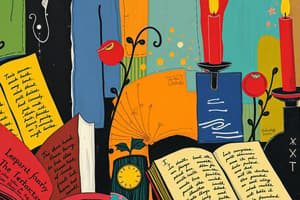Podcast
Questions and Answers
The sequence of events happening in a story is known as the ______.
The sequence of events happening in a story is known as the ______.
plot
A series of imagined facts which illustrates truths about human life is commonly called ______.
A series of imagined facts which illustrates truths about human life is commonly called ______.
fiction
The place and time where a story happens is referred to as the ______.
The place and time where a story happens is referred to as the ______.
setting
______ are the words uttered by the characters in a dramatic play.
______ are the words uttered by the characters in a dramatic play.
A brief artistic prose form is known as a ______.
A brief artistic prose form is known as a ______.
An extensive prose narrative that contains chapters and interludes is called a ______.
An extensive prose narrative that contains chapters and interludes is called a ______.
The central idea, thesis, or overall message that the story conveys is referred to as the ______.
The central idea, thesis, or overall message that the story conveys is referred to as the ______.
The moment of insight, discovery, or revelation of the main character after the falling action is known as the ______.
The moment of insight, discovery, or revelation of the main character after the falling action is known as the ______.
Irony refers to the opposites of what they actually ____
Irony refers to the opposites of what they actually ____
Flashback is a technique employed to help readers understand the ____
Flashback is a technique employed to help readers understand the ____
Conflict showcases the opposing objectives of the protagonist and the ____
Conflict showcases the opposing objectives of the protagonist and the ____
Deus ex machina originated from a Greek practice of lowering a ‘____’ to solve problems
Deus ex machina originated from a Greek practice of lowering a ‘____’ to solve problems
Text Structure refers to how the text is ____
Text Structure refers to how the text is ____
In a Cause & Effect text structure, one situation is ____ by another
In a Cause & Effect text structure, one situation is ____ by another
Imagery uses descriptive language to appeal to the ____
Imagery uses descriptive language to appeal to the ____
Verbal Irony is when someone says the ____ of what they mean
Verbal Irony is when someone says the ____ of what they mean
Flashcards are hidden until you start studying
Study Notes
Fiction and Drama
- Fiction is a series of imagined events that reveal human truths, commonly referred to as "stories."
- Two main forms of fiction: short stories and novels.
- Drama follows traditional fiction conventions but is performed on stage; its point of view is subtly conveyed through dialogue.
Elements of Fiction and Drama
- Plot: The sequence of events in a narrative.
- Setting: The time and place in which the story unfolds.
- Character: The individuals that populate the narrative.
- Theme: The central idea or message conveyed throughout the story.
Short Story and Novel
- Short Story: A concise form of artistic prose.
- Novel: An extensive prose narrative that includes chapters and interludes.
- Plays: Classified into acts; can be presented as one-act or three-act plays with specific focus on conflict and theme exposition.
Point of View and Dialogue
- Point of View: The perspective from which the story is told, influencing reader interpretation.
- Dialogue: The spoken exchanges between characters, essential for revealing drama's action and meaning.
Patterns of Fiction and Drama
- Exposition: Introduces characters and setting.
- Rising Action: Establishes conflict within the narrative.
- Climax: The crucial moment of crisis that elevates the conflict.
- Falling Action: Details the consequences of the climax.
- Resolution/Denouement: Provides insight or discovery post-conflict.
Narrative Devices
- Foreshadowing: Hints at future events to build anticipation.
- Irony:
- Represents contradictions between expectation and reality.
- Flashback: A technique that reveals past events for present context.
- Conflict: Highlights opposing goals between protagonist and antagonist.
- Deus ex Machina: A plot element resolving issues via unexplainable means, historically involving divine intervention.
Nonfiction Text Structures
- Text Structure: The organization of text to enhance understanding.
- Types of Text Structures:
- Description: Provides characteristics of one topic.
- Compare and Contrast: Highlights similarities and differences between topics.
- Order & Sequence: Outlines events in a specific order.
- Cause & Effect: Explains reasons behind events.
- Problem & Solution: Identifies a problem and suggests a resolution.
Literary Devices
- Metaphor and Simile:
- Metaphor directly states a comparison; simile uses "like" or "as."
- Imagery: Evocative language appealing to the senses.
- Symbolism: Represents broader ideas through symbols.
- Foreshadowing: Suggests future story developments.
- Irony: An incongruity between expected and actual outcomes.
Types of Irony
- Verbal Irony: A statement where the intended meaning is opposite of the literal meaning.
Studying That Suits You
Use AI to generate personalized quizzes and flashcards to suit your learning preferences.




